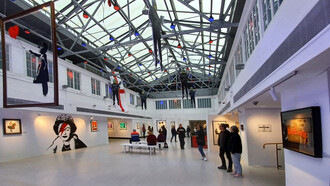Banksy. A visual protest, hosted by the Chiostro del Bramante from September 8, 2020 to April 11, 2021, was an ambitious exhibition abruptly interrupted by the Covid-19 healthcare emergency. In spite of that, the Chiostro employees continued delivering quality content to their costumers—both online and physically—throughout the seven months the exhibition took place.
Despite Covid restrictions, Banksy. A visual protest at the Chiostro del Bramante proved to be a successful post-lockdown experiment, reflecting the efforts of the team of curators and educators that worked on its organization.
First scheduled to open in March of 2020 and later postponed because of the pandemic, the exhibition developed on two floors and featured over 90 street art works, according to the Chiostro del Bramante’s page dedicated to the exhibition: from Love is in the Air to Girl with Balloon; from Queen Vic to Napalm, from Toxic Mary to HMV, from the press runs for the book Wall & Piece to the projects for vinyl and CD covers.
“There is a huge misconception when people think about Banksy: and that is that his art cannot be made into museum material,” said curator Natalia De Marco over the phone.
“The set-up of the exhibition reflects the curatorial spirit and the research that the exhibition office at the Chiostro made about the artist in the preparatory phase of the exhibition,” said the managing director for new projects, Gaia Casagrande, in an email interview.
The show was organized in collaboration with Il Sole 24 Ore Cultura and with the patronage of Regione Lazio – Assessorato alla Crescita Culturale.
The Chiostro’s most ambitious project since lockdown
The Ministerial Decree of October 24, 2020 released by the Italian Government legally allowed museum and cultural institutions to stay open during this second wave of cases if they respect Covid measures. Although this regulation did not directly affected cultural institutions, it nonetheless discouraged people in the Italian territory to avoid moving from a region to the other – or even from a city to the other – if it is not for health or work reasons, according to the managing director of the Educational Department, Silvia Andreozzi.
“If someone who purchased an exhibit-ticket tests positive to Covid, we give the buyer a credit to be used for a future ticket when they are able to travel again,” said Andreozzi.
The most challenging aspects in organizing Banksy’s exhibition were postponing the set-up decided before lockdown, revising the loan requests of the lenders and extending the insurance of the artworks, to name a few, according to Casagrande.
“Managing international transportations was probably the hardest part to deal with, taking into account the lockdowns around the world and the consequential inability to move from a country to the other,” said Casagrande.
According to Casagrande, there were some technical changes inside the spaces to abide by Covid protocol measures to ensure a safe visit, such as monitoring the number of visitors that are accessing every room at the same time and allowing them to download a guide directly on their phone.
The Chiostro employees – especially the education department and the ticket office – were able to work remotely even when museums were forced to close on November 3 as a response to the rising number of cases in Italy, according to Andreozzi.
“It’s not easy to work with an anonymous artist, especially at the times of Covid. But we’ve held on and now the numbers are rewarding us,” said De Marco.
The Chiostro is currently hosting the second part of their series of exhibitions about Banksy, titled All About Banksy: Exhibition 2, aiming at educating the public about the best-known anonymous street artist in the world.















